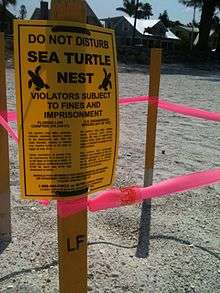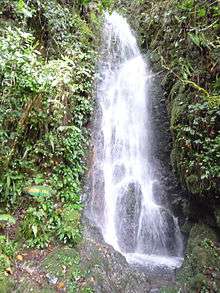Wildlife conservation

Wildlife Conservation is the practice of protecting wild plant and animal species and their habitats. The goal of wildlife conservation is to ensure that nature will be around for future generations to enjoy and also to recognize the importance of wildlife and wilderness for humans and other species alike.[1] Many nations have government agencies and NGO's dedicated to wildlife conservation, which help to implement policies designed to protect wildlife. Numerous independent non-profit organizations also promote various wildlife conservation causes.[2]
According to the National Wildlife Federation, wildlife in the United States gets a majority of their funding through appropriations from the federal budget, annual federal and state grants, and financial efforts from programs such as the Conservation Reserve Program, Wetlands Reserve Program and Wildlife Habitat Incentives Program.[3][4] Furthermore, a substantial amount of funding comes from the state through the sale of hunting/fishing licenses, game tags, stamps, and excise taxes from the purchase of hunting equipment and ammunition, which collects around $200 million annually.[5]
Wildlife conservation has become an increasingly important practice due to the negative effects of human activity on wildlife. An endangered species is defined as a population of a living species that is in the danger of becoming extinct because of several reasons.Some of The reasons can be, that 1. the species have a very low population, or 2. they are threatened by the varying environmental or prepositional parameters.
Major dangers to wildlife
Fewer natural wildlife habitat areas remain each year. Moreover, the habitat that remains has often been degraded to bear little resemblance to the wild areas which existed in the past.Habitat loss—due to destruction, fragmentation and degradation of habitat—is the primary threat to the survival of wildlife in the United States. When an ecosystem has an ecosystem are some of the ways habitats can become so degraded that they no longer support native wildlife.
- Climate change: Global warming is making hot days hotter, rainfall and flooding heavier, hurricanes stronger and droughts more severe. This intensification of weather and climate extremes will be the most visible impact of global warming in our everyday lives. It is also causing dangerous changes to the landscape of our world, adding stress to wildlife species and their habitat. Since many types of plants and animals have specific habitat requirements, climate change could cause disastrous loss of wildlife species. A slight drop or rise in average rainfall will translate into large seasonal changes. Hibernating mammals, reptiles, amphibians and insects are harmed and disturbed. Plants and wildlife are sensitive to moisture change so, they will be harmed by any change in moisture level. Natural phenomena like floods, earthquakes, volcanoes, lightning, forest fires.[6][7]
- Unregulated Hunting and poaching: Unregulated hunting and poaching causes a major threat to wildlife. Along with this, mismanagement of forest department and forest guards triggers this problem.
- Pollution: Pollutants released into the environment are ingested by a wide variety of organisms. Pesticides and toxic chemical being widely used, making the environment toxic to certain plants, insects, and rodents.
- Perhaps the largest threat is the extreme growing indifference of the public to wildlife, conservation and environmental issues in general.[8] Over-exploitation of resources, i.e., exploitation of wild populations for food has resulted in population crashes (over-fishing and over-grazing for example).
- Over exploitation is the over use of wildlife and plant species by people for food, clothing, pets, medicine, sport and many other purposes. People have always depended on wildlife and plants for food, clothing, medicine, shelter and many other needs. But today we are taking more than the natural world can supply. The danger is that if we take too many individuals of a species from their natural environment, the species may no longer be able to survive. The loss of one species can affect many other species in an ecosystem. The hunting, trapping, collecting and fishing of wildlife at unsustainable levels is not something new. The passenger pigeon was hunted to extinction, early in the last century, and over-hunting nearly caused the extinction of the American bison and several species of whales.
- Deforestation: Humans are continually expanding and developing, leading to an invasion of wildlife habitats. As humans continue to grow they clear forested land to crewe more space. This stresses wildlife populations as there are fewer homes and food sources to survive off of.
Population: The increasing population of human beings is the most major threat to wildlife. More people on the globe means more consumption of food,water and fuel . Therefore,more waste is generated. Every major threat to wildlife as seen above, is directly related to increasing population of human beings. If the population is altered so is the amount of risk to wildlife. The less is the population, less is the disturbance to wildlife.
Today, the [Endangered Species Act] protects some U.S. species that were in danger from over exploitation, and the Convention on International Trade in Endangered Species of Fauna and Flora (CITES) works to prevent the global trade of wildlife. But there are many species that are not protected from being illegally traded or over-harvested.
Wildlife conservation as a government involvement
In 1972, the Government of India enacted a law called the Wild Life (Protection) Act.The World Conservation Strategy was developed in 1980 by the "International Union for Conservation of Nature and Natural Resources" (IUCN) with advice, cooperation and financial assistance of the United Nations Environment Programme (UNEP) and the World Wildlife Fund and in collaboration with the Food and Agriculture Organization of the United Nations (FAO) and the United Nations Educational, Scientific and Cultural Organization (Unesco)"[9] The strategy aims to "provide an intellectual framework and practical guidance for conservation actions."[9] This thorough guidebook covers everything from the intended "users" of the strategy to its very priorities. It even includes a map section containing areas that have large seafood consumption and are therefore endangered by over fishing. The main sections are as follows:

- The objectives of conservation and requirements for their achievement:
- Maintenance of essential ecological processes and life-support systems.
- Preservation of genetic diversity that is flora and fauna.
- Sustainable utilization of species and ecosystems.
- Priorities for national action:
- A framework for national and sub-national conservation strategies.
- Policy making and the integration of conservation and development.
- Environmental planning and rational use allocation.
- Priorities for international action:
- International action: law and assistance.
- Tropical forests and dry lands.
- A global programme for the protection of genetic resource areas.
Map sections:
- Tropical forests
- Deserts and areas subject to desertification.
Non-government involvement
As major development agencies became discouraged with the public sector of environmental conservation in the late 1980s, these agencies began to lean their support towards the “private sector” or non-government organizations (NGOs).[10] In a World Bank Discussion Paper it is made apparent that “the explosive emergence of nongovernmental organizations” was widely known to government policy makers. Seeing this rise in NGO support, the U.S. Congress made amendments to the Foreign Assistance Act in 1979 and 1986 “earmarking U.S. Agency for International Development (USAID) funds for biodiversity”.[10] From 1990 moving through recent years environmental conservation in the NGO sector has become increasingly more focused on the political and economic impact of USAID given towards the “Environment and Natural Resources”.[11] After the terror attacks on the World Trade Centers on September 11, 2001 and the start of former President Bush’s War on Terror, maintaining and improving the quality of the environment and natural resources became a “priority” to “prevent international tensions” according to the Legislation on Foreign Relations Through 2002[11] and section 117 of the 1961 Foreign Assistance Act.[11] Furthermore, in 2002 U.S. Congress modified the section on endangered species of the previously amended Foreign Assistance Act.
Active non-government organizations
Many NGOs exist to actively promote, or be involved with wildlife conservation:
- The Nature Conservancy is a US charitable environmental organization that works to preserve the plants, animals, and natural communities that represent the diversity of life on Earth by protecting the lands and waters they need to survive.[12]
- World Wide Fund for Nature (WWF) is an international non-governmental organization working on issues regarding the conservation, research and restoration of the environment, formerly named the World Wildlife Fund, which remains its official name in Canada and the United States. It is the world's largest independent conservation organization with over 5 million supporters worldwide, working in more than 90 countries, supporting around 1300[4] conservation and environmental projects around the world. It is a charity, with approximately 60% of its funding coming from voluntary donations by private individuals. 45% of the fund's income comes from the Netherlands, the United Kingdom and the United States.[13]
- WildTeam
- Wildlife Conservation Society
- Audubon Society
- Traffic (conservation programme)
- Born Free Foundation
- WildEarth Guardians
See also
- Wildlife farming
- Conservation biology
- Conservation movement
- Wildlife management
- Conservation of plants and animals
References
- ↑ "Cooperative Alliance for Refuge Enhancement". CARE. Retrieved 1 June 2012.
- ↑ "Wildlife Conservation". Conservation and Wildlife. Retrieved 1 June 2012.
- ↑ "Conservation Funding - National Wildlife Federation". www.nwf.org. Retrieved 2016-01-21.
- ↑ "Wildlife and the Farm Bill - National Wildlife Federation". www.nwf.org. Retrieved 2016-01-21.
- ↑ Service, U.S. Fish and Wildlife. "Fish and Wildlife Service". www.fws.gov. Retrieved 2016-01-21.
- ↑ McCallum, M.L. 2010. Future climate change spells catastrophe for Blanchard's Cricket Frog (Acris blanchardi). Acta Herpetologica 5:119 - 130.
- ↑ McCallum, M.L., J.L. McCallum, and S.E. Trauth. 2009. Predicted climate change may spark box turtle declines. Amphibia-Reptilia 30:259 - 264.
- ↑ McCallum, M.L. and G.W. Bury. 2013. Google search patterns suggest declining interest in the environment. Biodiversity and Conservation DOI: 10.1007/s10531-013-0476-6
- 1 2 "World Conservation Strategy" (PDF). Retrieved 2011-05-01.
- 1 2 Meyer, Carrie A. (1993). "Environmental NGOs in Ecuador: An Economic Analysis of Institutional Change". The Journal of Developing Areas. 27 (2): 191–210. JSTOR 4192201.
- 1 2 3 "The Foreign Assistance Act of 1961, as amended" (PDF). Retrieved 2011-05-01.
- ↑ "About Us - Learn More About The Nature Conservancy". Nature.org. 2011-02-23. Retrieved 2011-05-01.
- ↑ "WWF in Brief". World Wildlife Fund. Retrieved 2011-05-01.
